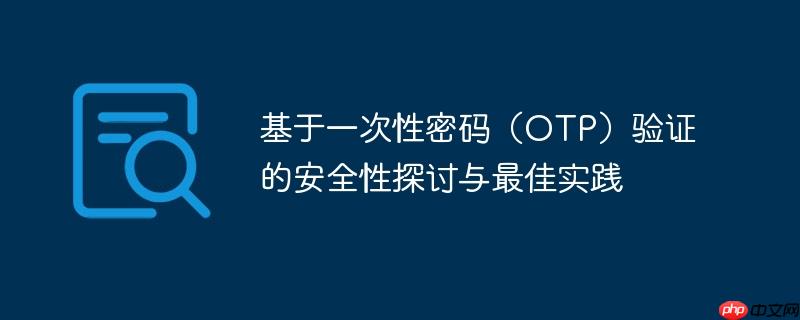
一次性密码(OTP)验证是一种常见的安全措施,用于在用户注册、登录或其他敏感操作中验证用户身份。然而,正如提问者所担忧的,如果用户A生成的OTP被用户B偶然猜中,并成功验证了用户A的账户,那么整个系统的安全性将受到威胁。虽然这种概率很低,但并非完全不可能发生,因此需要认真对待并采取相应的安全措施。
OTP系统的安全性主要取决于以下几个方面:
为了提高OTP系统的安全性,可以采取以下措施:
限制OTP的有效期: 将OTP的有效期设置为一个较短的时间段,例如几分钟或几小时。这样即使OTP泄露,攻击者也难以在有效期内利用它。
防止OTP重用: 在数据库中记录已使用的OTP,并在验证时检查OTP是否已被使用。如果OTP已被使用,则拒绝验证。
使用更安全的OTP生成算法: 避免使用简单的随机数生成器,而是采用更安全的加密算法生成OTP。例如,可以使用HMAC-SHA256算法,并结合用户特定的信息(例如用户名、邮箱地址)作为密钥。
以下是一个使用Java生成OTP的示例代码:
import javax.crypto.Mac;
import javax.crypto.spec.SecretKeySpec;
import java.nio.charset.StandardCharsets;
import java.security.InvalidKeyException;
import java.security.NoSuchAlgorithmException;
import java.util.Random;
public class OTPGenerator {
private static final String HMAC_SHA256 = "HmacSHA256";
public static String generateOTP(String secretKey, long timestamp, int length) throws NoSuchAlgorithmException, InvalidKeyException {
// Convert secret key to bytes
byte[] secretKeyBytes = secretKey.getBytes(StandardCharsets.UTF_8);
// Initialize HMAC-SHA256
SecretKeySpec secretKeySpec = new SecretKeySpec(secretKeyBytes, HMAC_SHA256);
Mac mac = Mac.getInstance(HMAC_SHA256);
mac.init(secretKeySpec);
// Convert timestamp to bytes
byte[] timestampBytes = String.valueOf(timestamp).getBytes(StandardCharsets.UTF_8);
// Compute HMAC
byte[] hmacBytes = mac.doFinal(timestampBytes);
// Convert to hex string
StringBuilder hexString = new StringBuilder(2 * hmacBytes.length);
for (byte b : hmacBytes) {
String hex = String.format("%02x", b);
hexString.append(hex);
}
// Take the last 'length' digits as OTP
String otp = hexString.substring(hexString.length() - length);
return otp;
}
public static void main(String[] args) throws NoSuchAlgorithmException, InvalidKeyException {
// Example usage
String secretKey = "your_secret_key"; // Replace with a strong, unique secret key
long timestamp = System.currentTimeMillis() / 30000; // Current time in 30-second intervals
int otpLength = 6;
String otp = generateOTP(secretKey, timestamp, otpLength);
System.out.println("Generated OTP: " + otp);
}
}注意事项:
实施速率限制: 限制每个用户在一定时间内请求OTP的次数,以防止暴力破解。
使用双因素认证(2FA): 将OTP与其他认证方式结合使用,例如密码、指纹等,可以进一步提高安全性。
虽然OTP系统存在一定的安全风险,但通过采取上述措施,可以有效降低这些风险,并构建一个安全的OTP验证系统。在设计和实现OTP系统时,务必充分考虑安全性,并根据实际情况选择合适的安全措施。记住,安全是一个持续改进的过程,需要不断评估和调整安全策略,以应对新的威胁。
以上就是基于一次性密码(OTP)验证的安全性探讨与最佳实践的详细内容,更多请关注php中文网其它相关文章!

每个人都需要一台速度更快、更稳定的 PC。随着时间的推移,垃圾文件、旧注册表数据和不必要的后台进程会占用资源并降低性能。幸运的是,许多工具可以让 Windows 保持平稳运行。

Copyright 2014-2025 https://www.php.cn/ All Rights Reserved | php.cn | 湘ICP备2023035733号